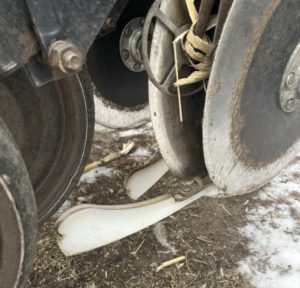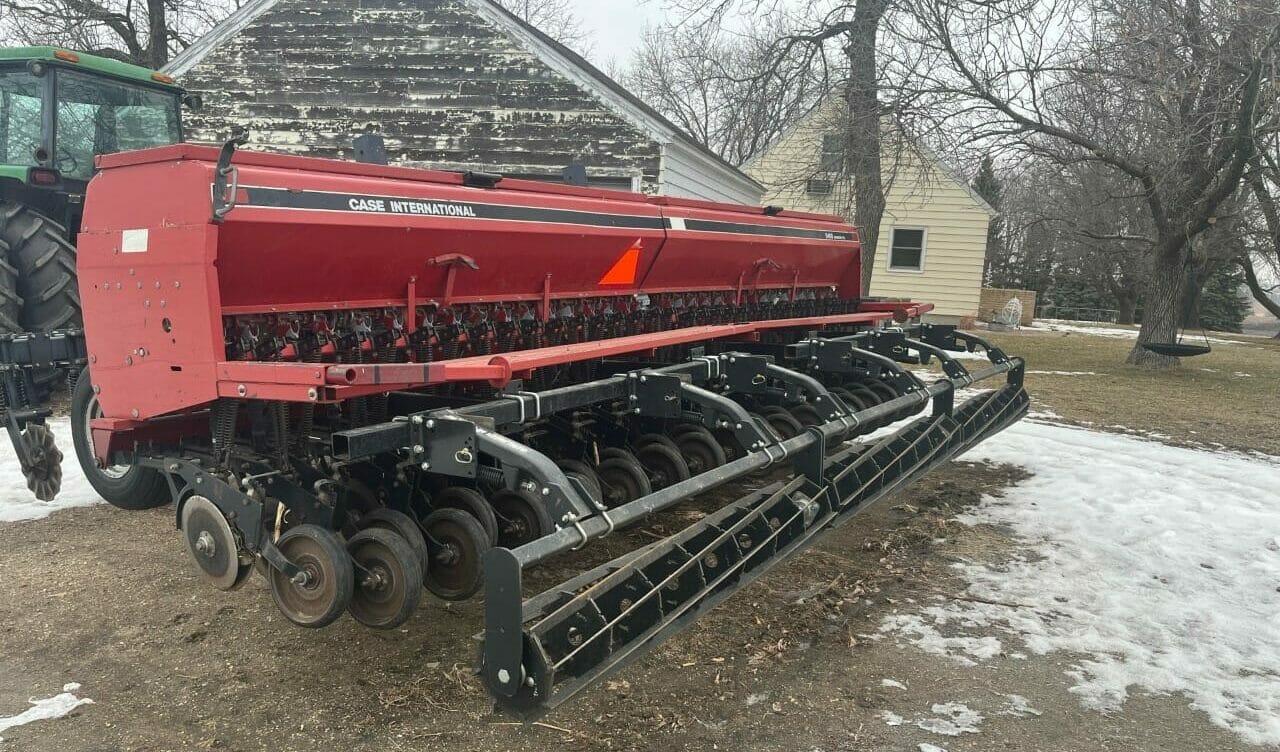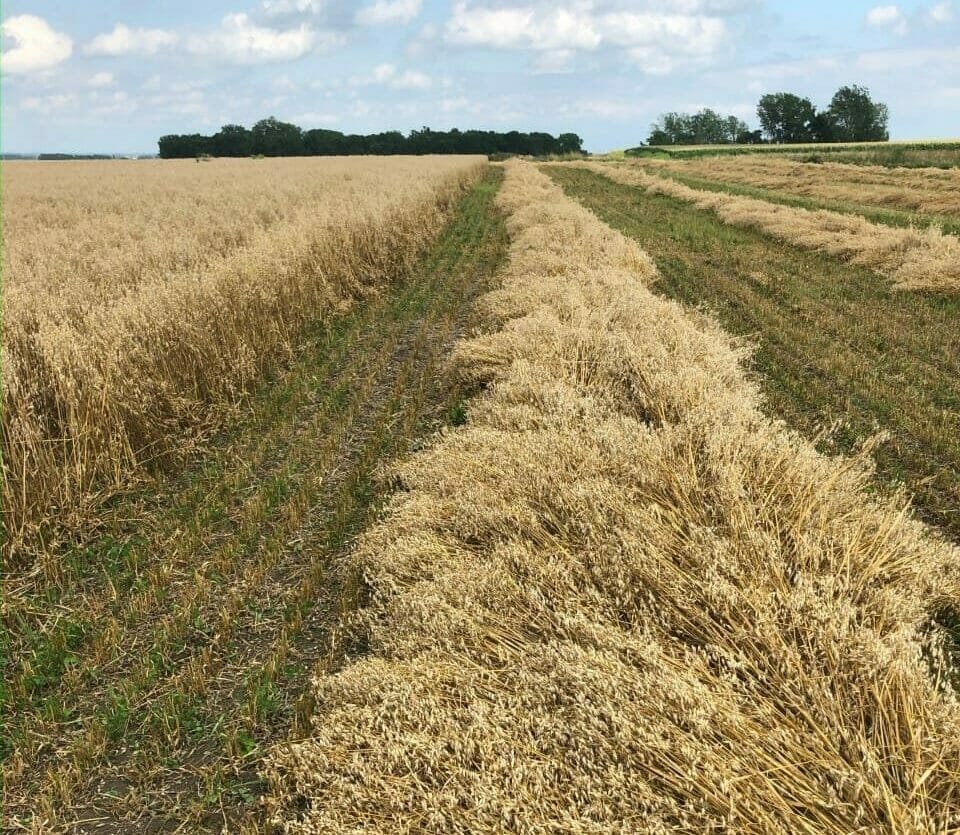Incorporating Oats in Extended Rotations
Each season of raising small grains is full of mindful choices, careful attention and constant learning. Ben Dwire has years of experience making adaptations for the specific needs of his crops and, in the process, has gained a great deal of insight for future seasons.
 Ben and his wife, Kristi, and two daughters live near Arco, Minnesota, just east of the South Dakota border and rotate oats, wheat, corn, rye and soybeans on nearly 600 acres. Their farm has been 100% no-till for the past eight years and they maintain cover crops on approximately two-thirds of those acres. Additionally, they graze their own cattle and sheep and often bring in neighbors’ livestock to graze as well, depending on the year. In March, on a shared learning call, Ben presented his particular insights on oat production – from planning to planting to harvesting – and all the helpful tips and critical decisions along the way.
Ben and his wife, Kristi, and two daughters live near Arco, Minnesota, just east of the South Dakota border and rotate oats, wheat, corn, rye and soybeans on nearly 600 acres. Their farm has been 100% no-till for the past eight years and they maintain cover crops on approximately two-thirds of those acres. Additionally, they graze their own cattle and sheep and often bring in neighbors’ livestock to graze as well, depending on the year. In March, on a shared learning call, Ben presented his particular insights on oat production – from planning to planting to harvesting – and all the helpful tips and critical decisions along the way.
Preparing to Plant
Small grains play a vital role in Ben’s crop rotations. He usually opts for oats, generally following soybeans and preceding corn. Ben recommends doing a soil test if possible; he uses a fertilizer blend of 50-40-40-15 (N-P-K-S). He also emphasizes the importance of doing research on plant varieties in advance of the planting season. “Of all the things you can do to raise food-grade oats, this is the one area that really doesn’t cost you any money and can make the difference between make and break,” he says.
Ben chooses his oat varieties based on a few criteria, with high test weight (38-40lbs/bu for food-grade) and high grain yield at the top of the list. In his area, crown and stem rust are both prevalent so he periodically reads up on trials from neighboring universities to find varieties with resistance to the fungus.
Additionally, he aims to find varieties that will produce a kernel with high plump:thin oat ratio. He says, “To get heavier test weight you will usually turn the fan up and run more air on the combine. If you have a high percentage of thins, those are all going to blow right off the back. A higher percentage of plumps keeps more of the grain in the combine.” Straw strength can also affect variety preferences if a farmer intends to use or sell the straw. If not, it’s best to find oats with shorter stems that are less likely to experience lodging from wind.
Seed to Soil
With an expected germination rate of 85-90%, Ben seeds 1.5 million in hopes of reaching 1.2 to 1.3 million mature oat plants per acre. When seeding time arrives, Ben stresses the importance of calibrating the drill. “Usually it takes maybe a half hour at the most and it’s not real hard, but it’ll save you a lot of time and frustration.” Then he confesses, “It never fails every year – I’ll get it calibrated, we’ll get started and I’ll start second guessing myself. And then I’ll play with it. And I will always end up exactly where we calibrated the first time.”
Ben recommends using a drill with high quality, sharp blades to place seeds in 6-to-8 inch spacing for an optimum stand of small grains. A drill attachment called a seed firmer then ensures that seeds get pushed securely into the soil. “We noticed an immediate difference in our emergence when we started using the seed firmer. Before, the seeds would come up more sporadically than we would like, but once we put those seed firmers on, they all come up at the same time.” To smooth ridges from a previous crop or simply firm the ground at the end of the seeding process, Ben attaches a rolling basket to the back of his drill.
As the summer continues, Ben keeps a close eye on his oat plants for crown rust and stem rust. To effectively apply fungicide, he watches closely for the flag leaf to sprout, which almost always happens around Father’s Day. “You need to have your sprayer cleaned out and ready to go because the window to spray is going to come and go really quick.” He adds, “It’s almost not worth putting fungicide on if you can’t hit the flag leaf.”
Harvest Time
For harvest, there are two main options – swathing or direct cutting. Both have distinct benefits and challenges and a farmer’s choice depends on weather and plant preferences. For Ben, swathing is a reliable method for achieving high test weight. “The nice thing about when you swath the oats is they go through a sweat out in the field, so if you don’t have air flow bins, this is a safer option.” Swathing is also a better option for getting good quality straw. Leaving the oats in windrows does, however, run the risk of getting too much or too little moisture while waiting for the right moment to harvest.
Direct cutting, on the other hand, is a quicker process, but requires more time blowing air on the oats since they are harvested before they go through the sweating phase. For both harvest methods, dust, chaff, and thin kernels are removed by turning up the combine fan and running the oats through the auger or grain vac. This, in turn, elevates the test weight.
Risk Management
Each year can bring a host of different challenges and changing conditions that make diversifying crops a wise component of farm risk management. Ben says, “Two years ago, my corn was horrible. The oats were just fine and the soybeans were pretty good. Last year, my corn was good. My oats were great. My beans were horrible. Something might fail, but the chances of having a failure in all three crops is pretty low. It just spreads your risk out a lot.” As a PFI Small Grain Cost-Share participant, Ben underseeds his small grains with a cover crop of red clover, which mitigates some risk by helping to suppress weeds and prevent soil erosion in addition to preserving nutrients for the following corn crop.
In an attempt to further diversify this year, Ben is planting more wheat. “The cool thing about small grains is it doesn’t have to always be one kind. It could be oats, it can be wheat, or it can be barley. You can kind of use them interchangeably.” With decreased disease and weed pressure and opportunity to graze, small grains are versatile crops that can make a dramatic difference.
More Information and Resources
Sign up for PFI’s monthly small grains email newsletter.
Register for our upcoming small grains shared learning calls via Zoom.
Sign up for our small grains cost-share program.



